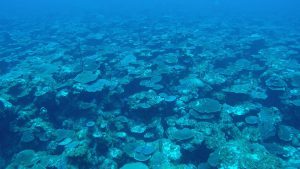A new modeling study by NOAA scientists and others at University of the Virgin Islands and Louisiana State University predicts the distribution of Orbicella corals in shallow and mesophotic reef ecosystems along a portion of the Puerto Rico shelf. These model results will help researchers identify areas of unexplored mesophotic coral habitat and guide the management and conservation of these Threatened coral species.

A mesophotic coral reef with an abundance of Orbicella corals located south of St. Thomas, U.S. Virgin Islands. Credit: Tyler Smith, University of the Virgin Islands.
Orbicella corals (common name: star corals) include three species: O. annularis, O. faveolata, and O. franksi, which are primary reef-building corals throughout the Caribbean in both shallow and mesophotic coral reef ecosystems. Mesophotic reef ecosystems are low light environments that globally occur between 30 and 150 meters, and along the Puerto Rico shelf, are abundant with O. faveolata and O. franksi in the upper mesophotic zone (30 - 60 meters deep). However, population declines of these coral species have occurred in U.S. waters causing all three to be listed as Threatened under the U.S. Endangered Species Act.
The models specifically show the potential location of Orbicella corals along a portion of the Puerto Rico shelf under typical environmental conditions using variables such as sea surface temperature, wave exposure, and seafloor topography. Not only will the models provide managers with information about potential Orbicella locations, they will also provide insights into unexplored areas of mesophotic reef habitat.
The models were developed by Katharine Egan when she was a graduate student at the University of the Virgin Islands and with CSS, Inc. under contract with NCCOS in Beaufort, North Carolina. Katharine is now a Physical Scientist with the NOAA Office of Ocean Exploration and Research.
This work was conducted with Dr. Shay Viehman (Research Ecologist, NCCOS), Dr. Daniel Holstein (Assistant Professor, Louisiana State University), Matthew Poti (Marine Biologist, NCCOS), Sarah Groves (Marine Spatial Ecologist, CSS Inc./NCCOS), and Dr. Tyler Smith (Research Associate Professor, University of the Virgin Islands).
This work is part of the NCCOS project on spatial predictive modeling of threatened corals in the U.S. Atlantic and Caribbean.
Citation: Egan, Katharine E., T. Shay Viehman, Daniel M. Holstein, Matthew Poti, Sarah H. Groves and Tyler B. Smith. 2021. Predicting the distribution of threatened orbicellid corals in shallow and mesophotic reef ecosystems. Marine Ecology Progress Series 667: 61-81. : https://doi.org/10.3354/meps13698
 Official websites use .gov
A .gov website belongs to an official government organization in the United States.
Official websites use .gov
A .gov website belongs to an official government organization in the United States. Secure .gov websites use HTTPS
A lock or https:// means you’ve safely connected to the .gov website. Share sensitive information only on official, secure websites.
Secure .gov websites use HTTPS
A lock or https:// means you’ve safely connected to the .gov website. Share sensitive information only on official, secure websites. Register for one of three virtual public listening sessions for South Florida Clean Coastal Waters Act
Register for one of three virtual public listening sessions for South Florida Clean Coastal Waters Act